Preliminary Observations from the China Fengyun-4A Lightning Mapping Imager and Its Optical Radiation Characteristics
Abstract
1. Introduction
2. Materials and Methods
2.1. FY-4A LMI
2.2. TRMM LIS
2.3. WWLLN
2.4. Analysis Methods
3. Results
3.1. Spatial Distribution Characteristics of Lightning
3.2. Temporal Variation Characteristics of Lightning
3.3. Optical Radiation Characteristics of Lightning Signals
4. Discussion
4.1. Coincidence between LMI Groups and WWLLN Strokes
4.2. Influence of LMI Data Processing on Observations
5. Conclusions
- High-flash density regions observed by the LMI were mainly concentrated over Southern East China, Southern South China, Eastern Southwest China, and Northeastern India. LMI flash densities were low over Western China. The flash density distribution pattern observed by the LMI was similar to those observed by the LIS and WWLLN over most regions but different over a small number of regions. LMI events, groups, and flashes exhibited similar spatial distribution patterns. Clustering of LMI groups into flashes more significantly affects the spatial distribution of flashes than clustering of events into groups.
- The outbreak of flashes observed by the LMI was concentrated in the premonsoon and monsoon seasons. LMI observations were similar to LIS observations, except that the LMI observed denser flashes over lower latitudes in the monsoon season. In addition, LMI and WWLLN flashes also exhibited similar distribution patterns in the premonsoon and monsoon seasons, except that the LMI observed denser flashes over Northeastern India in the monsoon season. For the LMI, event-to-group clustering more significantly affected the seasonal variation characteristics of flashes than group-to-flash clustering.
- LMI-observed peak flash rates over most regions occurred in the afternoon. LMI observations differed from LIS observations mainly over northeastern India. LMI flashes over this region were mainly concentrated in the morning, whereas LIS flashes over this region occurred at dusk. LMI observations differed from WWLLN observations mainly over Southeastern China and Northeastern India. The LMI-observed diurnal peak-flash rate period was slightly behind the WWLLN-observed diurnal peak-flash rate period.
- There was a “stepwise” decrease in each of the LMI-observed characteristic parameters of radiation in the lightning signals, namely, optical radiance, footprint size, duration, and number of groups per flash, from the ocean to the coastal regions to the inland regions, which was consistent with the LIS observations. In addition, there was an inverse correspondence between the distribution of each characteristic parameter of radiation and the density distribution of flashes observed by the LMI, which can explain the difference in flash density between regions. LMI flashes exhibit higher optical radiance and larger footprint sizes but lasted for shorter periods of time than LIS flashes. The optical radiance of the LMI flashes is related to the LMI calibration result. The larger footprint size of the LMI flashes is related to the higher spatial resolution of the LMI compared to that of the LIS. The shorter durations of the LMI flashes corresponded to the smaller number of groups per flash for the LMI than for the LIS, which is related to the LMI flash clustering algorithm.
- Onboard and ground data processing has an important impact on LMI detection. To filter out the background on the satellite, it is possible to more finely distinguish the background intensity over various regions based on the characteristics of the cloud background and the uniformity of CCD area arrays and set a more flexible, adaptive extraction threshold for lightning events. The LMI calibration results can be adjusted based on continuous monitoring of the radiation response characteristics of the CCD array. False lightning signals can be identified and filtered out by identifying known noises based on the geometric and shape features of images and based on the temporal and spatial extensibility of flashes. More stable flash clustering results can be obtained based on the characteristics of hierarchical clustering processes.
Author Contributions
Funding
Acknowledgments
Conflicts of Interest
References
- Williams, E.R. The global electrical circuit: A review. Atmos. Res. 2009, 91, 140–152. [Google Scholar] [CrossRef]
- Bruning, E.C.; Weiss, S.A.; Calhoun, K.M. Continuous variability in thunderstorm primary electrification and an evaluation of inverted-polarity terminology. Atmos. Res. 2014, 135–136, 274–284. [Google Scholar] [CrossRef]
- Williams, E.R.; Heckman, S.J. The local diurnal variation of cloud electrification and the global diurnal variation of negative charge on the Earth. J. Geophys. Res. Atmos. 1993, 98, 5221–5234. [Google Scholar] [CrossRef]
- Bond, D.W.; Steiger, S.; Zhang, R.; Tie, X.; Orville, R.E. The importance of NOx production by lightning in the tropics. Atmos. Environ. 2002, 36, 1509–1519. [Google Scholar] [CrossRef]
- Tie, X.; Zhang, R.; Brasseur, G.; Lei, W. Global NOx production by lightning. J. Atmos. Chem. 2002, 43, 61–74. [Google Scholar] [CrossRef]
- Reeve, N.; Toumi, R. Lightning activity as an indicator of climate change. Q. J. R. Meteorol. Soc. 1999, 125, 893–903. [Google Scholar] [CrossRef]
- Price, C. Evidence for a link between global lightning activity and upper tropospheric water vapour. Nature 2000, 406, 290–293. [Google Scholar] [CrossRef]
- Williams, E.R. Lightning and climate: A review. Atmos. Res. 2005, 76, 272–287. [Google Scholar] [CrossRef]
- Aich, V.; Holzworth, R.; Goodman, S.; Kuleshov, Y.; Price, C.; Williams, E. Lightning: A new essential climate variable. Eos 2018, 99. [Google Scholar] [CrossRef]
- Krider, E.P.; Noggle, R.C.; Uman, M.A. A gated, wideband magnetic direction finder for lightning return strokes. J. Appl. Meteorol. 1976, 15, 301–306. [Google Scholar] [CrossRef]
- Richard, P.; Auffray, G. VHF-UHF interferometric measurements, applications to lightning discharge mapping. Radio Sci. 1985, 20, 171–192. [Google Scholar] [CrossRef]
- Altaratz, O.; Levin, Z.; Yair, Y.; Ziv, B. Lightning activity over land and sea on the eastern coast of the Mediterranean. Mon. Wea. Rev. 2003, 131, 2060–2070. [Google Scholar] [CrossRef]
- Rhodes, C.T.; Shao, X.M.; Krehbiel, P.R.; Thomas, R.J.; Hayenga, C.O. Observations of lightning phenomena using radio interferometry. J. Geophys. Res. 1994, 99, 13059–13082. [Google Scholar] [CrossRef]
- Cummins, K.L.; Murphy, M.J.; Bardo, E.A.; Hiscox, W.L.; Pyle, R.B.; Pifer, A.E. A combined TOA/MDF technology upgrade of the U.S. national lightning detection network. J. Geophys. Res. Atmos. 1998, 103, 9035–9044. [Google Scholar] [CrossRef]
- Biagi, C.J.; Cummins, K.L.; Kehoe, K.E.; Krider, E.P. National lightning detection network (NLDN) performance in southern Arizona, Texas, and Oklahoma in 2003–2004. J. Geophys. Res. 2007, 112, 1435–1440. [Google Scholar] [CrossRef]
- Betz, H.D.; Schmidt, K.; Laroche, P.; Blanchet, P.; Oettinger, W.P.; Defer, E.; Dziewit, Z.; Konarski, J. LINET—An international lightning detection network in Europe. Atmos. Res. 2009, 91, 564–573. [Google Scholar] [CrossRef]
- Yao, W.; Zhang, Y.; Meng, Q.; Wang, F.; Lu, W. A comparison of the characteristics of total and cloud-to-ground lightning activities in hailstorms. Acta Meteorol. Sin. 2013, 27, 282–293. [Google Scholar] [CrossRef]
- Yang, X.; Sun, J.; Li, W. An analysis of cloud-to-ground lightning in China during 2010–2013. Weather Forecast. 2015, 30, 1537–1550. [Google Scholar] [CrossRef]
- Abarca, S.F.; Corbosiero, K.L.; Galarneau, T.J. An evaluation of the worldwide lightning location network (WWLLN) using the national lightning detection network (NLDN) as ground truth. J. Geophys. Res. 2010, 115, D18206. [Google Scholar] [CrossRef]
- Hutchins, M.L.; Holzworth, R.H.; Virts, K.S.; Wallace, J.M.; Heckman, S. Radiated VLF energy differences of land and oceanic lightning. Geophys. Res. Lett. 2013, 40, 2390–2394. [Google Scholar] [CrossRef]
- Said, R.K.; Cohen, M.B.; Inan, U.S. Highly intense lightning over the oceans: Estimated peak currents from global GLD360 observations. J. Geophys. Res. Atmos. 2013, 118, 6905–6915. [Google Scholar] [CrossRef]
- Rudlosky, S.D.; Peterson, M.J.; Kahn, D.T. GLD360 performance relative to TRMM LIS. J. Atmos. Ocean. Technol. 2017, 34, 1307–1322. [Google Scholar] [CrossRef]
- Boccippio, D.J.; Heckman, S.; Goodman, S.J. A diagnostic analysis of the Kennedy Space Center LDAR network: 1. Data characteristics. J. Geophys. Res. Atmos. 2001, 106, 4769–4786. [Google Scholar] [CrossRef]
- Rison, W.; Thomas, R.J.; Krehbiel, P.R.; Hamlin, T.; Harlin, J. A GPS-based three-dimensional lightning mapping system: Initial observations in central New Mexico. Geophys. Res. Lett. 1999, 26, 3573–3576. [Google Scholar] [CrossRef]
- Liu, C.; Heckman, S. Using total lightning data in severe storm prediction: Global case study analysis from north America, Brazil and Australia. In Proceedings of the 2011 International Symposium on Lightning Protection, Fortaleza, Brazil, 3–7 October 2011; IEEE: Fortaleza, Brazil, 2011; pp. 20–24. [Google Scholar]
- Wu, F.; Cui, X.; Zhang, D.; Liu, D.; Zheng, D. SAFIR-3000 lightning statistics over the Beijing metropolitan region during 2005–2007. J. Appl. Meteorol. Clim. 2016, 55, 2613–2633. [Google Scholar] [CrossRef]
- Boccippio, D.J.; Koshak, W.; Blakeslee, R.; Driscoll, K.; Mach, D.; Buechler, D.; Boeck, W.; Christian, H.J.; Goodman, S.J. The optical transient detector (OTD): Instrument characteristics and cross-sensor validation. J. Atmos. Ocean. Technol. 2000, 17, 441–458. [Google Scholar] [CrossRef]
- Christian, H.J.; Blakeslee, R.J.; Goodman, S.J.; Mach, D.M. Algorithm Theoretical Basis Document (ATBD) for the Lightning Imaging Sensor (LIS); NASA Technical Report; NASA: Washington, DC, USA, 2000.
- Boccippio, D.J.; Koshak, W.J.; Blakeslee, R.J. Performance assessment of the optical transient detector and lightning imaging sensor. Part I: Predicted diurnal variability. J. Atmos. Ocean. Technol. 2002, 19, 1318–1332. [Google Scholar] [CrossRef]
- Finke, U.; Kreyer, O. Detect and Locate Lightning Events from Geostationary Satellite Observations. Report Part I. Review of Existing Lightning Location Systems; EUMETSAT Report, EUM/CO/02/1016/SAT; EUMESTAT: Darmstadt, Germany, 2002. [Google Scholar]
- Albrecht, R.I.; Goodman, S.J.; Buechler, D.E.; Blakeslee, R.J.; Christian, H.J. Where are the lightning hotspots on earth? Bull. Am. Meteorol. Soc. 2016, 97, 2051–2068. [Google Scholar] [CrossRef]
- Christian, H.J.; Blakeslee, R.J.; Goodman, S.J. The detection of lightning from geostationary orbit. J. Geophys. Res. 1989, 94, 13329–13337. [Google Scholar] [CrossRef]
- Chauzy, S.; Coquillat, S.; Soula, S. On the Relevance of Lightning Imagery from Geostationary Satellite Observation for Operational Meteorological Applications; EUMETSAT Technical Report EUM/COL/LET/02/1562; EUMESTAT: Darmstadt, Germany, 2002. [Google Scholar]
- Chen, S.B.; Yang, Y.; Cui, T.F. Study of the cloud effect on lightning detection by geostationary satellite. Chin. J. Geophys. 2012, 55, 797–803. [Google Scholar] [CrossRef]
- Goodman, S.J.; Blakeslee, R.J.; Koshak, W.J.; Mach, D.; Bailey, J.; Buechler, D.; Carey, L.; Schultz, C.; Bateman, M.; McCaul, E.; et al. The GOES-R geostationary lightning mapper (GLM). Atmos. Res. 2013, 125–126, 34–49. [Google Scholar] [CrossRef]
- Rudlosky, S.D.; Goodman, S.J.; Koshak, W.J.; Blakeslee, R.J.; Buechler, D.E.; Mach, D.M.; Bateman, M. Characterizing the GOES-R (GOES-16) geostationary lightning mapper (GLM) on-orbit performance. In Proceedings of the 2017 IEEE International Geoscience and Remote Sensing Symposium (IGARSS), Fort Worth, TX, USA, 23–28 July 2017; IEEE: Fort Worth, TX, USA, 2017; pp. 279–282. [Google Scholar]
- Bateman, M.; Mach, D.; Blakeslee, R.J.; Koshak, W.J. Preliminary assessment of detection efficiency for the Geostationary Lightning Mapper using intercomparisons with ground-based systems. In Proceedings of the 2018 American Meteorological Society Annual Meeting, Austin, TX, USA, 7–11 January 2018; AMS: Austin, TX, USA, 2020. [Google Scholar]
- Rudlosky, S.D.; Goodman, S.J.; Virts, K.S.; Bruning, E.C. Initial geostationary lightning mapper observations. Geophys. Res. Lett. 2019, 46, 1097–1104. [Google Scholar] [CrossRef]
- Marchand, M.; Hilburn, K.; Miller, S.D. Geostationary lightning mapper and earth networks lightning detection over the contiguous united states and dependence on flash characteristics. J. Geophys. Res. Atmos. 2019, 124, 11552–11567. [Google Scholar] [CrossRef]
- Peterson, M. Research applications for the geostationary lightning mapper operational lightning flash data product. J. Geophys. Res. Atmos. 2019, 124, 10205–10231. [Google Scholar] [CrossRef]
- Yang, J.; Zhang, Z.; Wei, C.; Lu, F.; Guo, Q. Introducing the new generation of Chinese geostationary weather satellites, Fengyun-4. Bull. Am. Meteorol. Soc. 2017, 98, 1637–1658. [Google Scholar] [CrossRef]
- Liu, R.-X.; Liu, T.; Pessi, A.; Hui, W.; Cheng, W.; Huang, F.-X. Preliminary study on the influence of FY-4 lightning data assimilation on precipitation predictions. J. Trop. Meteorol. 2019, 25, 528–541. [Google Scholar] [CrossRef]
- Hui, W.; Huang, F.; Liu, R. Characteristics of lightning signals over the Tibetan Plateau and the capability of FY-4A LMI lightning detection in the Plateau. Int. J. Remote Sens. 2020, 41, 4605–4625. [Google Scholar] [CrossRef]
- Zhang, W.; Hui, W.; Lyu, W.; Cao, D.; Li, P.; Zheng, D.; Fang, X.; Zhang, Y. FY-4A LMI observed lightning activity in super Typhoon Mangkhut (2018) in comparison with WWLLN data. J. Meteorol. Res. 2020, 34, 336–352. [Google Scholar] [CrossRef]
- Grandell, J.; Finke, U.; Stuhlmann, R. The EUMETSAT meteosat third generation lightning imager (MTG-LI): Applications and product processing. In Proceedings of the 9th EMS Annual Meeting, Toulouse, France, 28 September–2 October 2009. [Google Scholar]
- Defer, E.; Bovalo, C.; Coquillat, S.; Pinty, J.-P.; Farges, T.; Krehbiel, P.; Rison, W. Learning from concurrent lightning imaging sensor and lightning mapping array observations in preparation for the MTG-LI mission. In Proceedings of the EGU General Assembly Conference, Vienna, Austria, 17–22 April 2016. [Google Scholar]
- Dobber, M.; Kox, S. Meteosat Third Generaton (MTG) Lightning Imager (LI) calibration and 0–1b data processing. In Proceedings of the 25th CALCON Technical Conference, Loveland, CO, USA, 23 August 2016. [Google Scholar]
- Kokou, P.; Willemsen, P.; Lekouara, M.; Arioua, M.; Mora, A.; Van den Braembussche, P.; Neri, E.; Aminou, D.M.A. Algorithmic chain for lightning detection and false event filtering based on the MTG lightning imager. IEEE Trans. Geosci. Remote Sens. 2018, 56, 5115–5124. [Google Scholar] [CrossRef]
- Bao, S.; Li, Y.; Tang, S.; Liang, H.; Zhao, X. Instantaneous real-time detection technology of GLI on FY-4 geostationary meteorological satellite. Aerosp. China 2017, 18, 23–30. [Google Scholar]
- Liang, H.; Bao, S.; Chen, Q.; Zhao, X.; Li, Y. Design and implementation of FY-4 geostationary lightning imager. Aerosp. Shanghai 2017, 34, 43–51. [Google Scholar]
- Cecil, D.J.; Buechler, D.E.; Blakeslee, R.J. Gridded lightning climatology from TRMM-LIS and OTD: Dataset description. Atmos. Res. 2014, 135–136, 404–414. [Google Scholar] [CrossRef]
- Christian, H.J.; Blakeslee, R.J.; Goodman, S.J. Lightning Imaging Sensor (LIS) for the Earth Observing System; NASA Technical Memorandum 4350; NASA: Washington, DC, USA, 1992.
- Christian, H.J.; Blakeslee, R.J.; Boccippio, D.J.; Koshak, W.J.; Goodman, S.J.; Mach, D.M. Science Data Validation Plan for the Lightning Imaging Sensor (LIS); NASA Technical Report; NASA: Washington, DC, USA, 2000.
- Buechler, D.E.; Koshak, W.J.; Christian, H.J.; Goodman, S.J. Assessing the performance of the lightning imaging sensor (LIS) using deep convective clouds. Atmos. Res. 2014, 135–136, 397–403. [Google Scholar] [CrossRef]
- Virts, K.S.; Wallace, J.M.; Hutchins, M.L.; Holzworth, R.H. Highlights of a new ground-based, hourly global lightning climatology. Bull. Am. Meteorol. Soc. 2013, 94, 1381–1391. [Google Scholar] [CrossRef]
- Lay, E.H.; Holzworth, R.H.; Rodger, C.J.; Thomas, J.N.; Pinto, O.; Dowden, R.L. WWLL global lightning detection system: Regional validation study in Brazil. Geophys. Res. Lett. 2004, 31, L03102. [Google Scholar] [CrossRef]
- Rodger, C.J.; Brundell, J.B.; Dowden, R.L. Location accuracy of VLF world-wide lightning location (WWLL) network: Post-algorithm upgrade. Ann. Geophys. 2005, 23, 277–290. [Google Scholar] [CrossRef]
- Jacobson, A.R.; Holzworth, R.; Harlin, J.; Dowden, R.; Lay, E. Performance assessment of the world wide lightning location network (WWLLN), using the Los Alamos Sferic Array (LASA) as ground truth. J. Atmos. Ocean. Technol. 2006, 23, 1082–1092. [Google Scholar] [CrossRef]
- Rodger, C.J.; Werner, S.; Brundell, J.B.; Lay, E.H.; Thomson, N.R.; Holzworth, R.H.; Dowden, R.L. Detection efficiency of the VLF world-wide lightning location network (WWLLN): Initial case study. Ann. Geophys. 2006, 24, 3197–3214. [Google Scholar] [CrossRef]
- Lay, E.H.; Jacobson, A.R.; Holzworth, R.H.; Rodger, C.J.; Dowden, R.L. Local time variation in land/ocean lightning flash density as measured by the world wide lightning location network. J. Geophys. Res. Atmos. 2007, 112, D13111. [Google Scholar] [CrossRef]
- Dowden, R.L.; Brundell, J.B.; Rodger, C.J. VLF lightning location by time of group arrival (TOGA) at multiple sites. J. Atmos. Sol. Terr. Phys. 2002, 64, 817–830. [Google Scholar] [CrossRef]
- Rodger, C.J.; Brundell, J.B.; Dowden, R.L.; Thomson, N.R. Location accuracy of long distance VLF lightning locationnetwork. Ann. Geophys. 2004, 22, 747–758. [Google Scholar] [CrossRef]
- Hutchins, M.L.; Holzworth, R.H.; Brundell, J.B.; Rodger, C.J. Relative detection efficiency of the world wide lightning location network. Radio Sci. 2012, 47, RS6005. [Google Scholar] [CrossRef]
- Rodger, C.J.; Brundell, J.B.; Holzworth, R.H.; Lay, E.H. Growing detection efficiency of the world wide lightning location network. AIP Conf. Proc. 2009, 1118, 15–20. [Google Scholar] [CrossRef]
- Segundo, H.S.; López, J.A.; Pineda, N.; Altube, P.; Montanyà, J. Sensitivity analysis of lightning stroke-to-flash grouping criteria. Atmos. Res. 2020, 242, 105023. [Google Scholar] [CrossRef]
- Fan, P.; Zheng, D.; Zhang, Y.; Gu, S.; Zhang, W.; Yao, W.; Yan, B.; Xu, Y. A performance evaluation of the world wide lightning location network (WWLLN) over the Tibetan Plateau. J. Atmos. Ocean. Technol. 2018, 35, 927–939. [Google Scholar] [CrossRef]
- Zhang, W.; Zhang, Y.; Zheng, D.; Xu, L.; Lyu, W. Lightning climatology over the northwest Pacific region: An 11-year study using data from the world wide lightning location network. Atmos. Res. 2018, 210, 41–57. [Google Scholar] [CrossRef]
- Abarca, S.F.; Corbosiero, K.L.; Vollaro, D. The World Wide Lightning Location Network and convective activity in tropical cyclones. Mon. Weather Rev. 2011, 139, 175–191. [Google Scholar] [CrossRef]
- Price, C.; Asfur, M.; Yair, Y. Maximum hurricane intensity preceded by increase in lightning frequency. Nat. Geosci. 2009, 2, 329–332. [Google Scholar] [CrossRef]
- Thomas, J.N.; Solorzano, N.N.; Cummer, S.A.; Holzworth, R.H. Polarity and energetics of inner core lightning in three intense North Atlantic hurricanes. J. Geophys. Res. Atmos. 2010, 115, A00E15. [Google Scholar] [CrossRef]
- DeMaria, M.; DeMaria, R.T.; Knaff, J.A.; Molenar, D. Tropical cyclone lightning and rapid intensity change. Mon. Weather Rev. 2012, 140, 1828–1842. [Google Scholar] [CrossRef]
- Stevenson, S.N.; Corbosiero, K.L.; Molinari, J. The convective evolution and rapid intensification of Hurricane Earl (2010). Mon. Weather Rev. 2014, 142, 4364–4380. [Google Scholar] [CrossRef]
- Solorzano, N.N.; Thomas, J.N.; Hutchins, M.L.; Holzworth, R.H. WWLLN lightning and satellite microwave radiometrics at 37 to 183 GHz: Thunderstorms in the broad tropics. J. Geophys. Res. Atmos. 2016, 121, 12298–12318. [Google Scholar] [CrossRef]
- Price, C.; Asfur, M. Can lightning observations be used as an indicator of upper-tropospheric water vapor variability? Bull. Am. Meteorol. Soc. 2006, 87, 291–298. [Google Scholar] [CrossRef]
- Zhang, Y.; Ma, M.; Lu, W.; Tao, S. Review on climate characteristics of lightning activity. Acta Meteorol. Sin. 2010, 24, 137–149. [Google Scholar]
- Qie, X.; Toumi, R.; Zhou, Y. Lightning activity on the central Tibetan Plateau and its response to convective available potential energy. Chin. Sci. Bull. 2003, 48, 296–299. [Google Scholar] [CrossRef]
- Tinmaker, M.I.R.; Aslam, M.Y.; Chate, D.M. Lightning activity and its association with rainfall and convective available potential energy over Maharashtra, India. Nat. Hazards 2015, 77, 293–304. [Google Scholar] [CrossRef]
- Li, W.; Qie, X.; Fu, S.; Su, D.; Shen, Y. Simulation of quasi-linear mesoscale convective systems in northern China: Lightning activities and storm structure. Adv. Atmos. Sci. 2016, 33, 85–100. [Google Scholar] [CrossRef]
- Hegerl, G.C.; Wallace, J.M. Influence of patterns of climate variability on the difference between satellite and surface temperature trends. J. Clim. 2002, 15, 2412–2428. [Google Scholar] [CrossRef][Green Version]
- Thapliyal, P.K.; Vinayak, M.; Ajil, K.S.; Shah, S.; Pal, P.K.; Joshi, P.C. Estimation of upper tropospheric humidity from water vapour channel of very high-resolution radiometer onboard INSAT-3A and Kalpana satellites. In Proceedings of the Remote Sensing of the Atmosphere and Clouds, Goa, India, 8 December 2006; SPIE: Goa, India, 2006; p. 640807. [Google Scholar]
- Kahn, B.H.; Gettelman, A.; Fetzer, E.J.; Eldering, A.; Liang, C.K. Cloudy and clear-sky relative humidity in the upper troposphere observed by the A-train. J. Geophys. Res. 2009, 114, D00H02. [Google Scholar] [CrossRef]
- Riemann-Campe, K.; Fraedrich, K.; Lunkeit, F. Global climatology of convective available potential energy (CAPE) and convective inhibition (CIN) in ERA-40 reanalysis. Atmos. Res. 2009, 93, 534–545. [Google Scholar] [CrossRef]
- Dewan, A.; Ongee, E.T.; Rafiuddin, M.; Rahman, M.M.; Mahmood, R. Lightning activity associated with precipitation and CAPE over Bangladesh. Int. J. Climatol. 2018, 38, 1649–1660. [Google Scholar] [CrossRef]
- Christian, H.J.; Blakeslee, R.J.; Boccippio, D.J.; Boeck, W.L.; Buechler, D.E.; Driscoll, K.T.; Goodman, S.J.; Hall, J.M.; Koshak, W.J.; Mach, D.M.; et al. Global frequency and distribution of lightning as observed from space by the Optical Transient Detector. J. Geophys. Res. 2003, 108, 4005. [Google Scholar] [CrossRef]
- Cecil, D.J.; Buechler, D.E.; Blakeslee, R.J. TRMM LIS climatology of thunderstorm occurrence and conditional lightning flash rates. J. Clim. 2015, 28, 6536–6547. [Google Scholar] [CrossRef]
- Orville, R.E.; Huffines, G.R.; Burrows, W.R.; Cummins, K.L. The North American lightning detection network (NALDN)—Analysis of flash data: 2001–2009. Mon. Weather Rev. 2011, 139, 1305–1322. [Google Scholar] [CrossRef]
- Kandalgaonkar, S.S.; Tinmaker, M.I.R.; Kulkarni, J.R.; Nath, A. Diurnal variation of lightning activity over the Indian region. J. Geophys. Res. 2003, 30, 2022. [Google Scholar] [CrossRef]
- Kandalgaonkar, S.S.; Tinmaker, I.R.; Kulkarni, J.R.; Nath, A.; Kulkarni, M.; Trimbake, H.K. Spatio-temporal variability of lightning activity over the Indian region. J. Geophys. Res. 2005, 110, D11108. [Google Scholar] [CrossRef]
- Zheng, Y.G.; Chen, J.; Zhu, P. Climatological distribution and diurnal variation of mesoscale convective systems over China and its vicinity during summer. Sci. Bull. 2008, 53, 1574–1586. [Google Scholar] [CrossRef]
- Xia, R.; Zhang, D.-L.; Wang, B. A 6-yr cloud-to-ground lightning climatology and its relationship to rainfall over central and eastern China. J. Appl. Meteorol. Climatol. 2015, 54, 2443–2460. [Google Scholar] [CrossRef]
- Master, M.J.; Uman, M.A.; Lin, Y.T.; Standler, R.B. Calculations of lightning return stroke electric and magnetic fields above ground. J. Geophys. Res. 1981, 86, 12127–12132. [Google Scholar] [CrossRef]
- Quick, M.G.; Krider, E.P. Optical power and energy radiated by natural lightning. J. Geophys. Res. Atmos. 2013, 118, 1868–1879. [Google Scholar] [CrossRef]
- Orville, R.E. Peak-current variations of lightning return strokes as a function of latitude. Nature 1990, 343, 149–151. [Google Scholar] [CrossRef]
- Rudlosky, S.D.; Fuelberg, H.E. Seasonal, regional, and storm-scale variability of cloud-to-ground lightning characteristics in Florida. Mon. Weather Rev. 2011, 139, 1826–1843. [Google Scholar] [CrossRef]
- Beirle, S.; Koshak, W.; Blakeslee, R.; Wagner, T. Global patterns of lightning properties derived by OTD and LIS. Nat. Hazards Earth Syst. Sci. 2014, 14, 2715–2726. [Google Scholar] [CrossRef]
- Qu, H.; Yuan, P.; Zhang, T.; Chang, Z. Analysis on the correlation between temperature and discharge characteristic of cloud-to-ground lightning discharge plasma with multiple return strokes. Phys. Plasmas 2011, 18, 013504. [Google Scholar] [CrossRef]
- Wang, D.; Takagi, N.; Watanabe, T.; Rakov, V.A.; Uman, M.A.; Rambo, K.J.; Stapleton, M.V. A comparison of channel-base currents and optical signals for rocket-triggered lightning strokes. Atmos. Res. 2005, 76, 412–422. [Google Scholar] [CrossRef]
- You, J.; Zheng, D.; Zhang, Y.; Yao, W.; Meng, Q. Duration, spatial size and radiance of lightning flashes over the Asia-Pacific region based on TRMM/LIS observations. Atmos. Res. 2019, 223, 98–113. [Google Scholar] [CrossRef]
- He, H.; Zhang, F. Diurnal variations of warm-season precipitation over Northern China. Mon. Weather Rev. 2010, 138, 1017–1025. [Google Scholar] [CrossRef]
- Siingh, D.; Kumar, P.R.; Kulkarni, M.N.; Singh, R.P.; Singh, A.K. Lightning, convective rain and solar activity—Over the South/Southeast Asia. Atmos. Res. 2013, 120–121, 99–111. [Google Scholar] [CrossRef]
- Finke, U. Optical detection of lightning from space. In Lightning: Principles, Instruments and Applications; Betz, H.D., Schumann, U., Laroche, P., Eds.; Springer: Dordrecht, The Netherlands, 2009; pp. 271–286. [Google Scholar]
- Williams, E.; Rothkin, K.; Stevenson, D.; Boccippio, D. Global lightning variations caused by changes in thunderstorm flash rate and by changes in the number of thunderstorms. J. Appl. Meteorol. 2000, 39, 2223–2230. [Google Scholar] [CrossRef]
- Boccippio, D.J.; Goodman, S.J.; Heckman, S. Regional differences in tropical lightning distributions. J. Appl. Meteorol. 2000, 39, 2231–2248. [Google Scholar] [CrossRef]
- Williams, E.; Stanfill, S. The physical origin of the land–ocean contrast in lightning activity. C. R. Phys. 2002, 3, 1277–1292. [Google Scholar] [CrossRef]
- Zheng, D.; Zhang, Y.; Meng, Q.; Chen, L.; Dan, J. Climatological comparison of small- and large-current cloud-to-ground lightning flashes over Southern China. J. Clim. 2016, 29, 2831–2848. [Google Scholar] [CrossRef]
- Zhou, E.; Lu, W.; Zhang, Y.; Zhu, B.; Zheng, D.; Zhang, Y. Correlation analysis between the channel current and luminosity of initial continuous and continuing current processes in an artificially triggered lightning flash. Atmos. Res. 2013, 129–130, 79–89. [Google Scholar] [CrossRef]
- Bruning, E.C.; MacGorman, D.R. Theory and observations of controls on lightning flash size spectra. J. Atmos. Sci. 2013, 70, 4012–4029. [Google Scholar] [CrossRef]
- Zheng, D.; MacGorman, D.R. Characteristics of flash initiations in a supercell cluster with tornadoes. Atmos. Res. 2016, 167, 249–264. [Google Scholar] [CrossRef]
- Zhang, Z.; Zheng, D.; Zhang, Y.; Lu, G. Spatial–temporal characteristics of lightning flash size in a supercell storm. Atmos. Res. 2017, 197, 201–210. [Google Scholar] [CrossRef]
- Chronis, T.; Lang, T.; Koshak, W.; Blakeslee, R.; Christian, H.; McCaul, E.; Bailey, J. Diurnal characteristics of lightning flashes detected over the São Paulo lightning mapping array. J. Geophys. Res. Atmos. 2015, 120, 11799–11808. [Google Scholar] [CrossRef]
- Peterson, M.; Deierling, W.; Liu, C.; Mach, D.; Kalb, C. The properties of optical lightning flashes and the clouds they illuminate. J. Geophys. Res. Atmos. 2017, 122, 423–442. [Google Scholar] [CrossRef]
- Qie, X.; Toumi, R.; Yuan, T. Lightning activities on the Tibetan Plateau as observed by the lightning imaging sensor. J. Geophys. Res. 2003, 108, 1–10. [Google Scholar] [CrossRef]
- Xu, W. Precipitation and convective characteristics of summer deep convection over East Asia Observed by TRMM. Mon. Weather Rev. 2013, 141, 1577–1592. [Google Scholar] [CrossRef]
- Qie, X.; Wu, X.; Yuan, T.; Bian, J.; Lu, D. Comprehensive pattern of deep convective systems over the Tibetan Plateau–South Asian monsoon region based on TRMM data. J. Clim. 2014, 27, 6612–6626. [Google Scholar] [CrossRef]
- Chen, J.; Wu, X.; Yin, Y.; Huang, Q.; Xiao, H. Characteristics of cloud systems over the Tibetan Plateau and East China during Boreal Summer. J. Clim. 2017, 30, 3117–3137. [Google Scholar] [CrossRef]
- Li, Y.; Zhang, G.; Wen, J.; Wang, D.; Wang, Y.; Zhang, T.; Fan, X.; Wu, B. Electrical structure of a Qinghai–Tibet Plateau thunderstorm based on three-dimensional lightning mapping. Atmos. Res. 2013, 134, 137–149. [Google Scholar] [CrossRef]
- Wang, H.; Guo, X. Comparative analyses of vertical structure of deep convective clouds retrieved from satellites and ground-based radars at Naqu over the Tibetan Plateau. J. Meteorol. Res. 2019, 33, 446–462. [Google Scholar] [CrossRef]
- Orville, R.E.; Huffines, G.R. Cloud-to-ground lightning in the United States: NLDN results in the first decade, 1989–1998. Mon. Weather Rev. 2001, 129, 1179–1193. [Google Scholar] [CrossRef]
- Rakov, V.A.; Huffines, G.R. Return-stroke multiplicity of negative cloud-to-ground lightning flashes. J. Appl. Meteorol. 2003, 42, 1455–1462. [Google Scholar] [CrossRef]
- Yair, Y.; Shalev, S.; Erlich, Z.; Agrachov, A.; Katz, E.; Saaroni, H.; Price, C.; Ziv, B. Lightning flash multiplicity in eastern Mediterranean thunderstorms. Nat. Hazards Earth Syst. Sci. 2014, 14, 165–173. [Google Scholar] [CrossRef]
- Orville, R.E.; Huffines, G.R. Lightning ground flash measurements over the contiguous United States: 1995–1997. Mon. Weather Rev. 1999, 127, 2693–2703. [Google Scholar] [CrossRef]
- Montanyà, J.; Soula, S.; Pineda, N. A study of the total lightning activity in two hailstorms. J. Geophys. Res. Atmos. 2007, 112, D13118. [Google Scholar] [CrossRef]
- Tan, Y.-B.; Tao, S.-C.; Zhu, B.-Y.; Ma, M.; LÜ, W.-T. A simulation of the effects of intra-cloud lightning discharges on the charges and electrostatic potential distributions in a thundercloud. Chin. J. Geophys. 2007, 50, 916–930. [Google Scholar] [CrossRef]
- Zhang, D.; Cummins, K.L. Time evolution of satellite-based optical properties in lightning flashes, and its impact on GLM flash detection. J. Geophys. Res. Atmos. 2020, 125, e2019JD032024. [Google Scholar] [CrossRef]
- Koshak, W.J.; Stewart, M.F.; Christian, H.J.; Bergstrom, J.W.; Hall, J.M.; Solakiewicz, R.J. Laboratory calibration of the optical transient detector and the lightning imaging sensor. J. Atmos. Ocean. Technol. 2000, 17, 905–915. [Google Scholar] [CrossRef]
- Zhang, D.; Cummins, K.L.; Bitzer, P.; Koshak, W.J. Evaluation of the performance characteristics of the lightning imaging sensor. J. Atmos. Ocean. Technol. 2019, 36, 1015–1031. [Google Scholar] [CrossRef]
- Grandell, J. Algorithm Theoretical Basis Document (ATBD) for L2 Processing of the MTG Lightning Imager Data; EUMETSAT Technical Report EUM/MTG/DOC/11/0155; EUMESTAT: Darmstadt, Germany, 2011. [Google Scholar]
- Goodman, S.J.; Mach, D.; Koshak, W.; Blakeslee, R. GLM Lightning Cluster-Filter Algorithm; NOAA NESDIS Center for Satellite Applications and Research, Algorithm Theoretical Basis Document, Version 3.0; NOAA NESDIS STAR: College Park, MD, USA, 2012. [Google Scholar]
- Mach, D.M.; Christian, H.J.; Blakeslee, R.J.; Boccippio, D.J.; Goodman, S.J.; Boeck, W.L. Performance assessment of the optical transient detector and lightning imaging sensor. J. Geophys. Res. 2007, 112, D09210. [Google Scholar] [CrossRef]
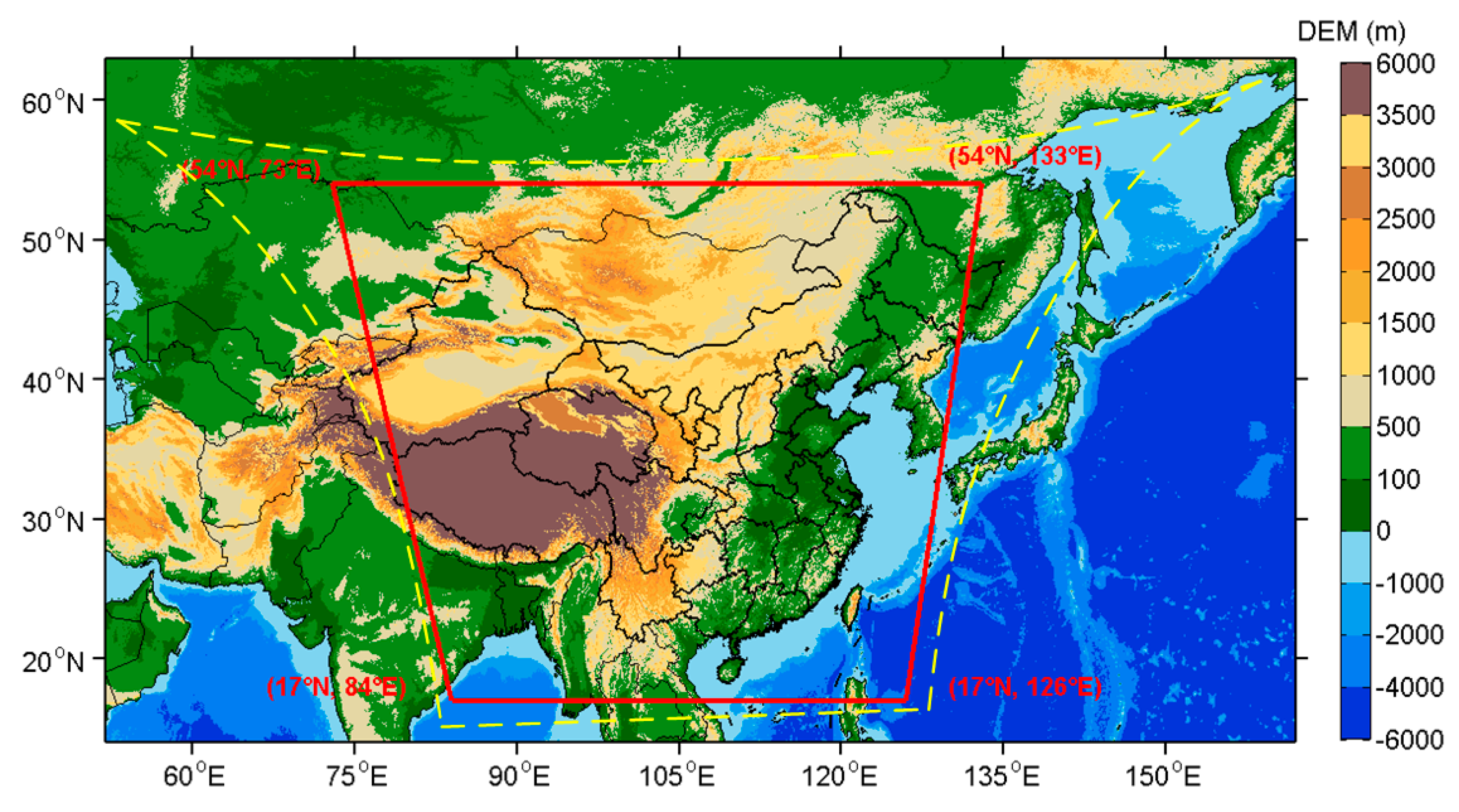
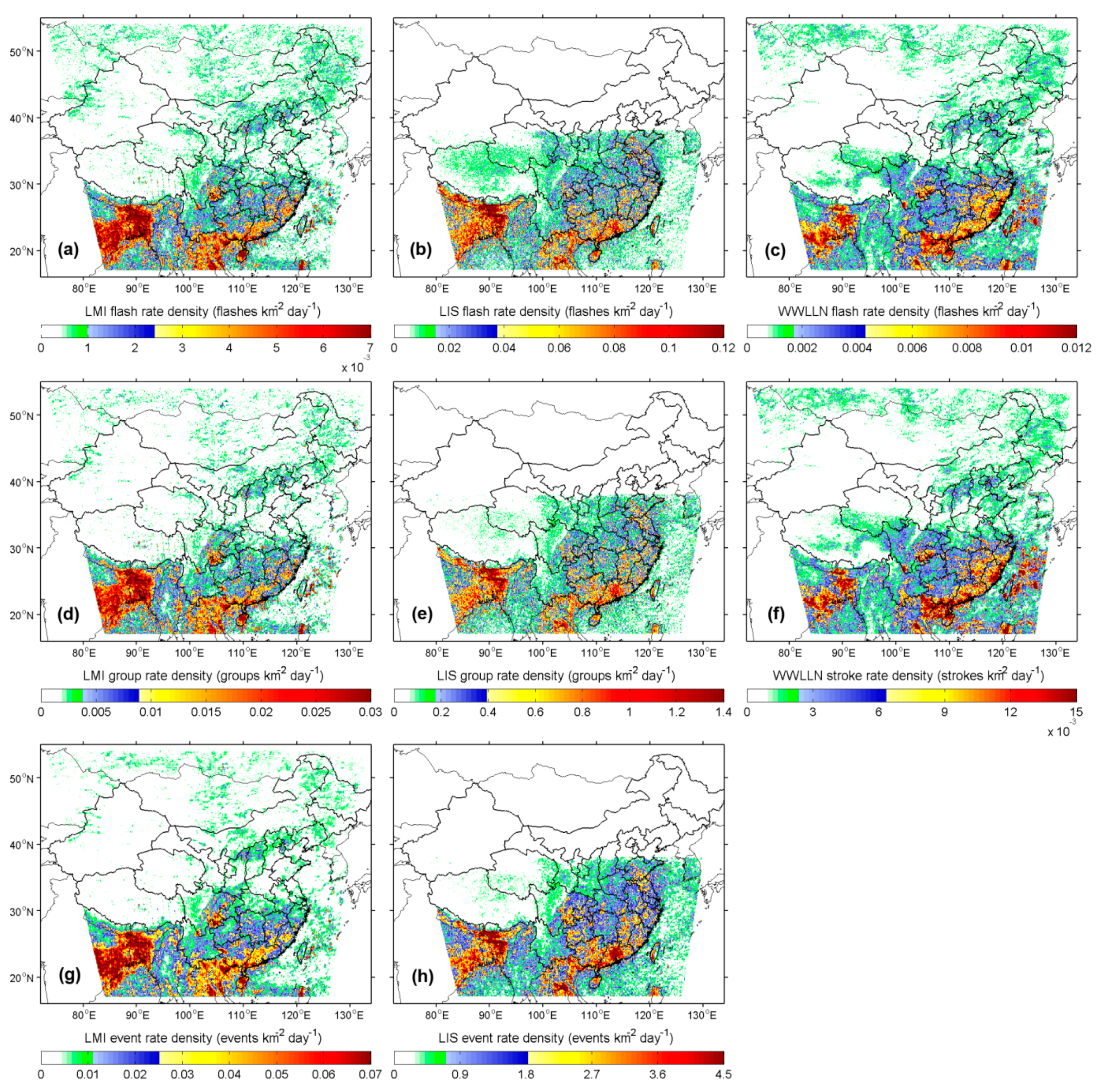
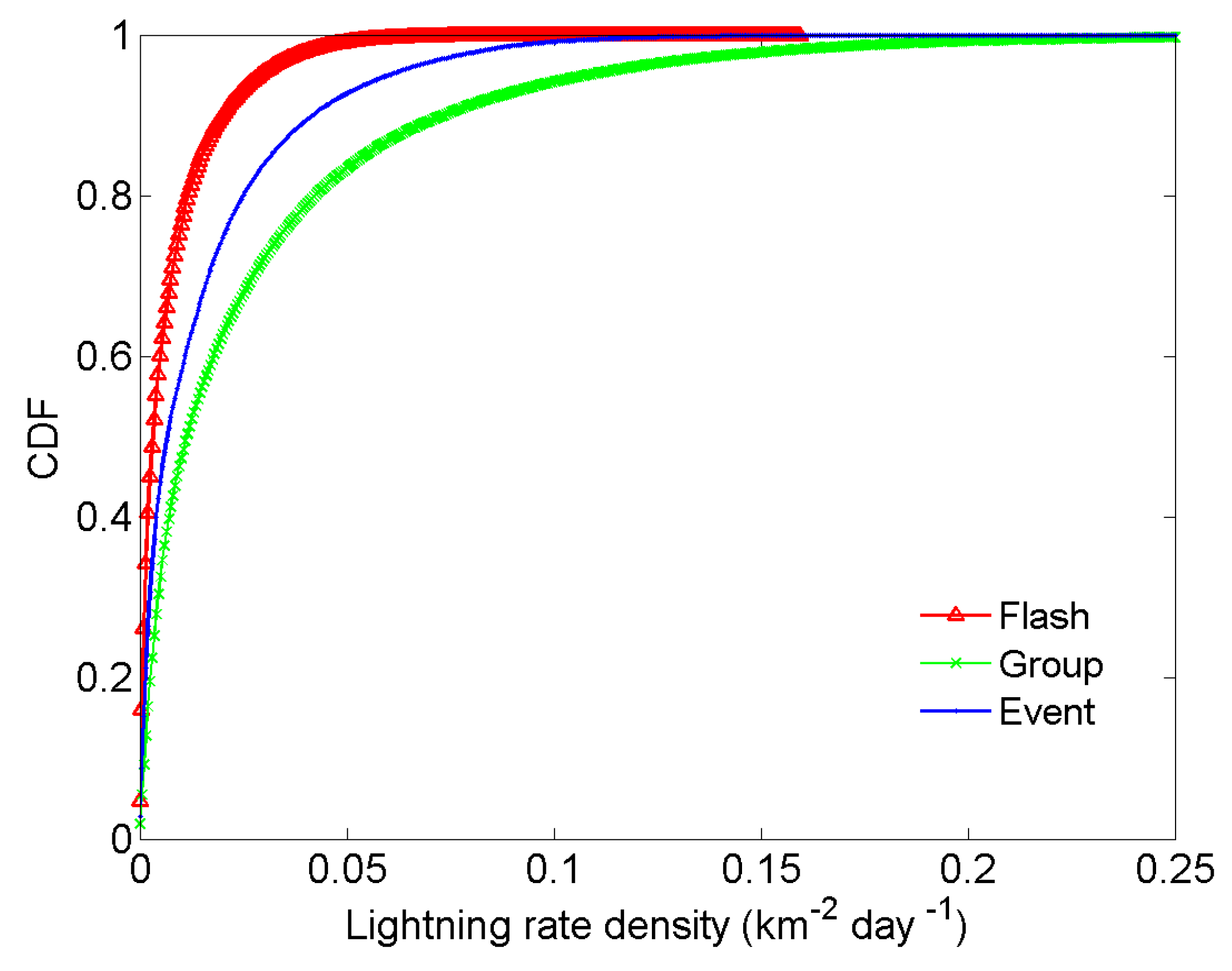
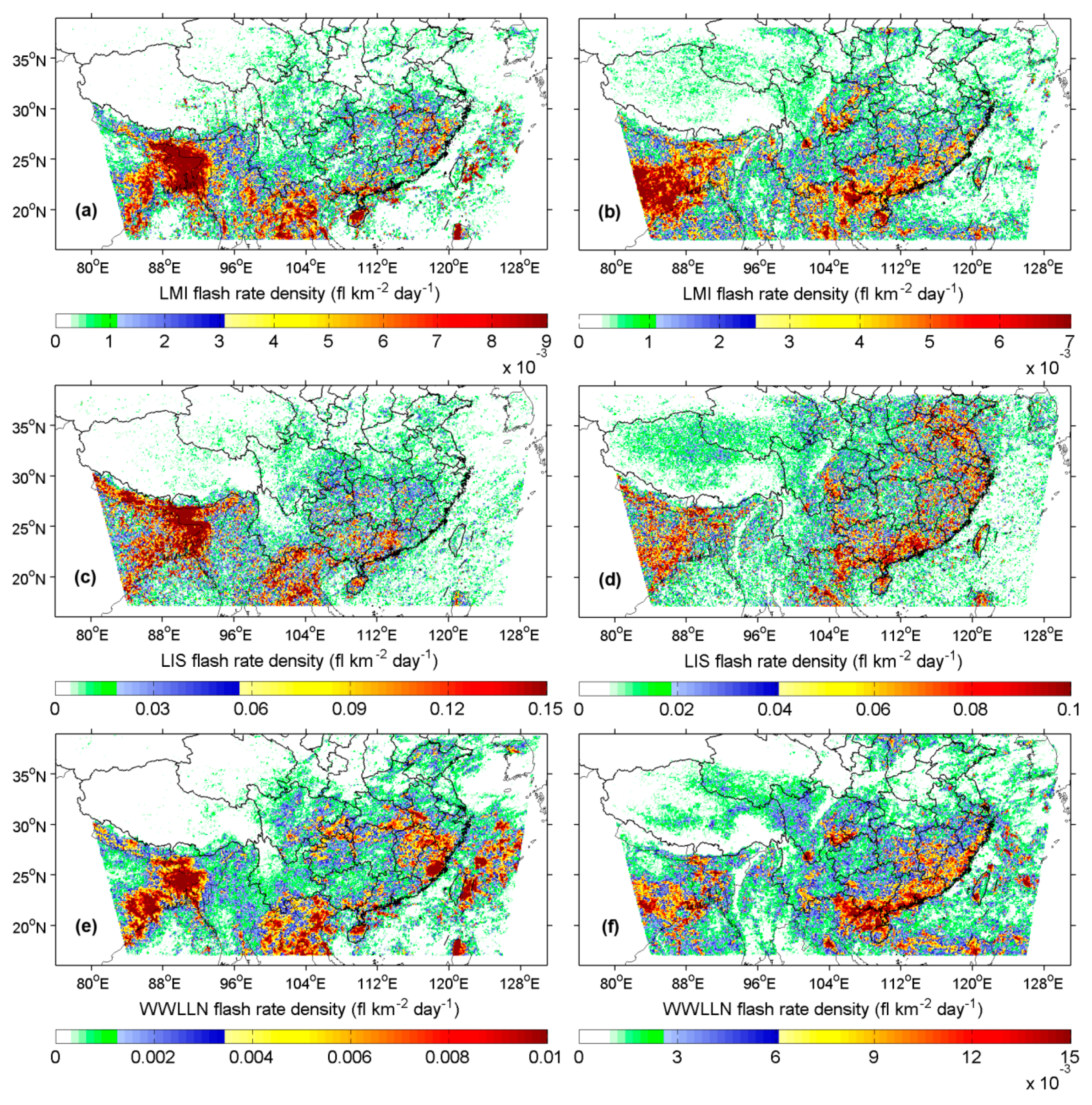
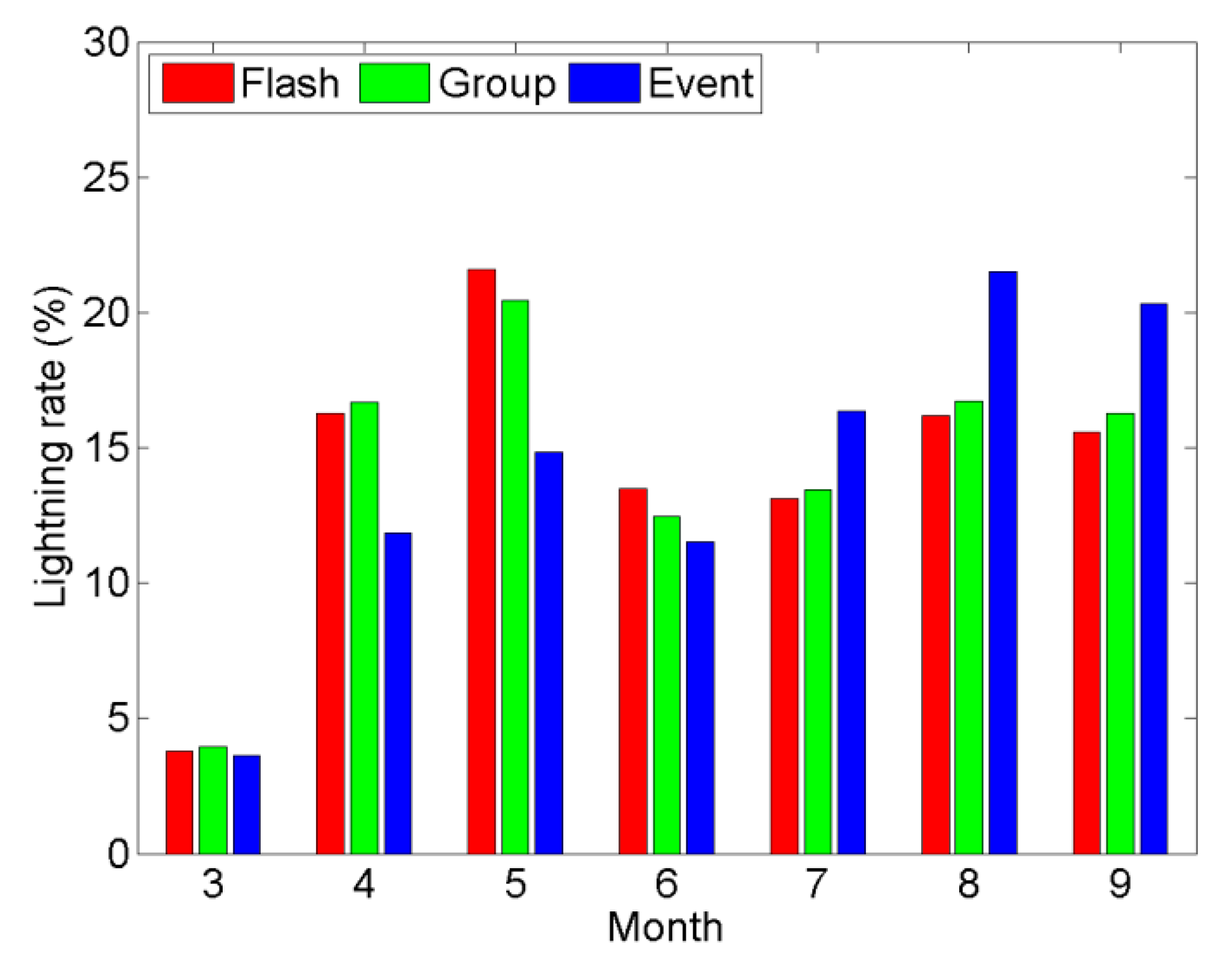
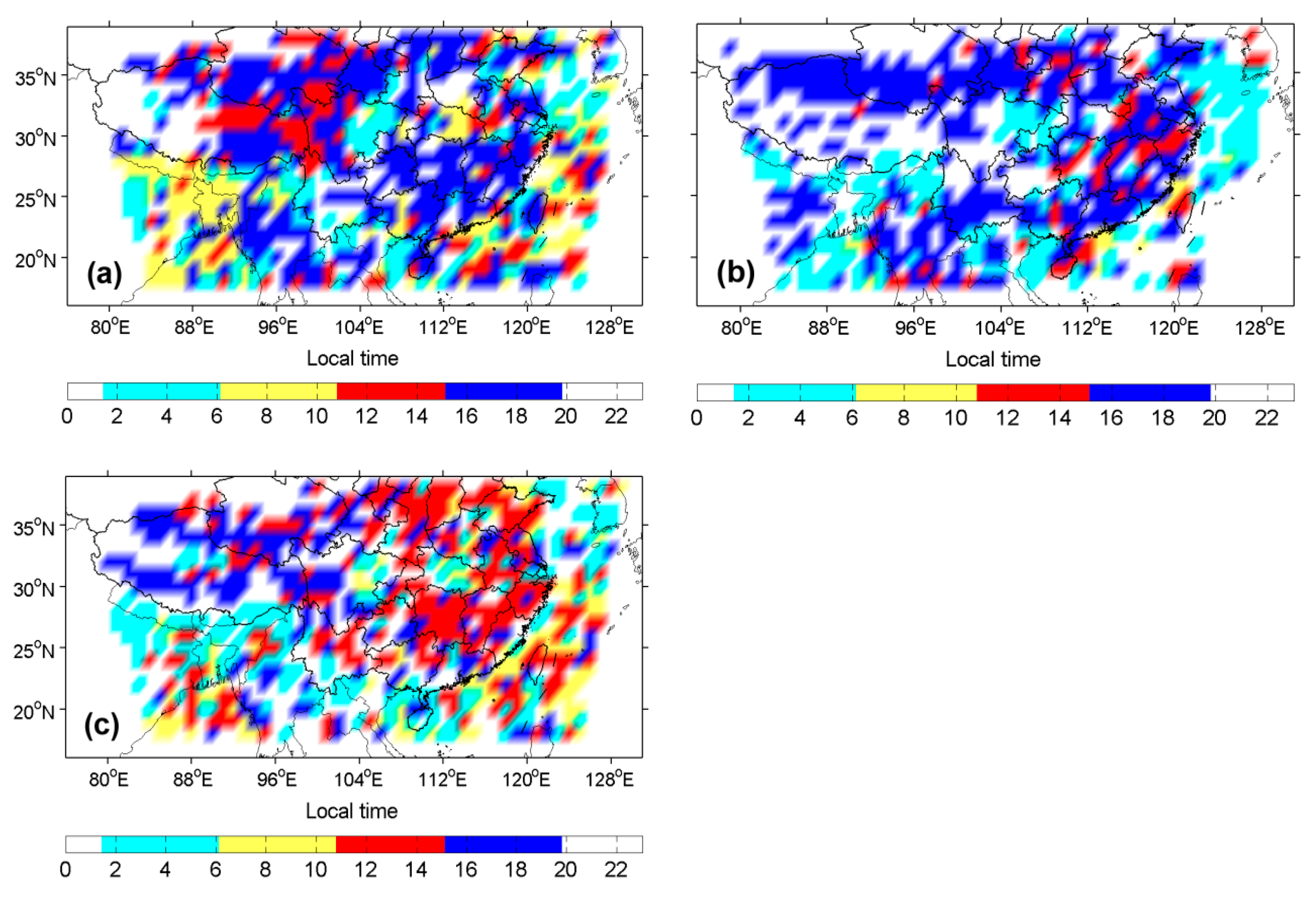
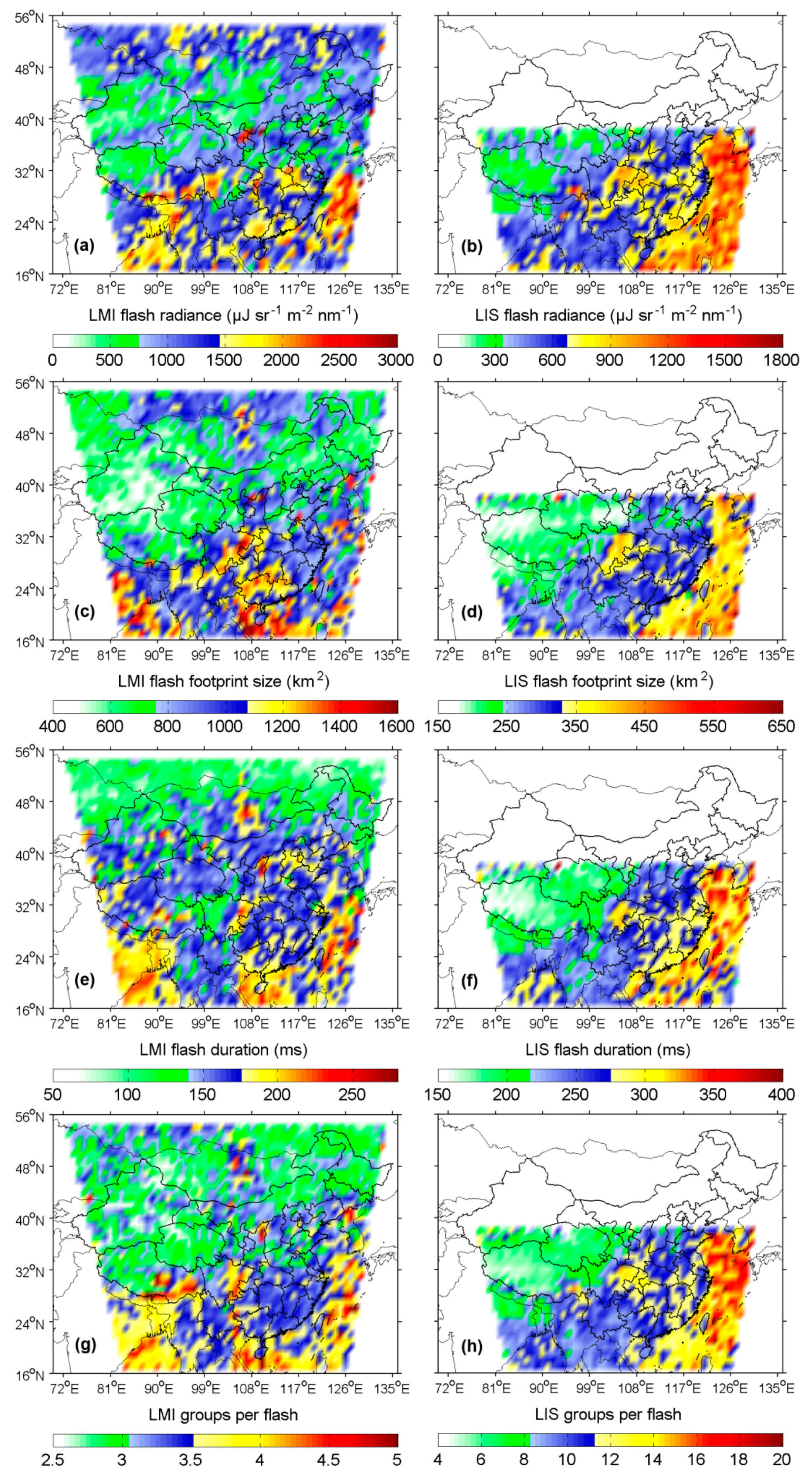
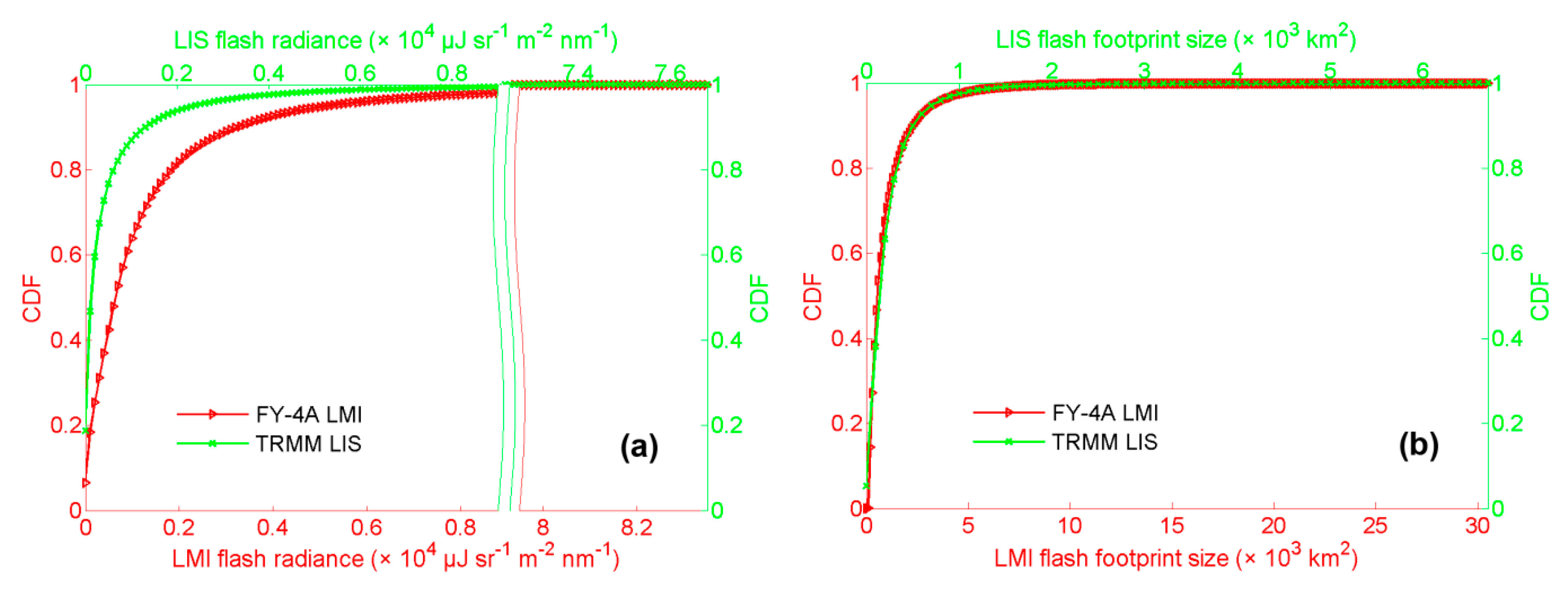
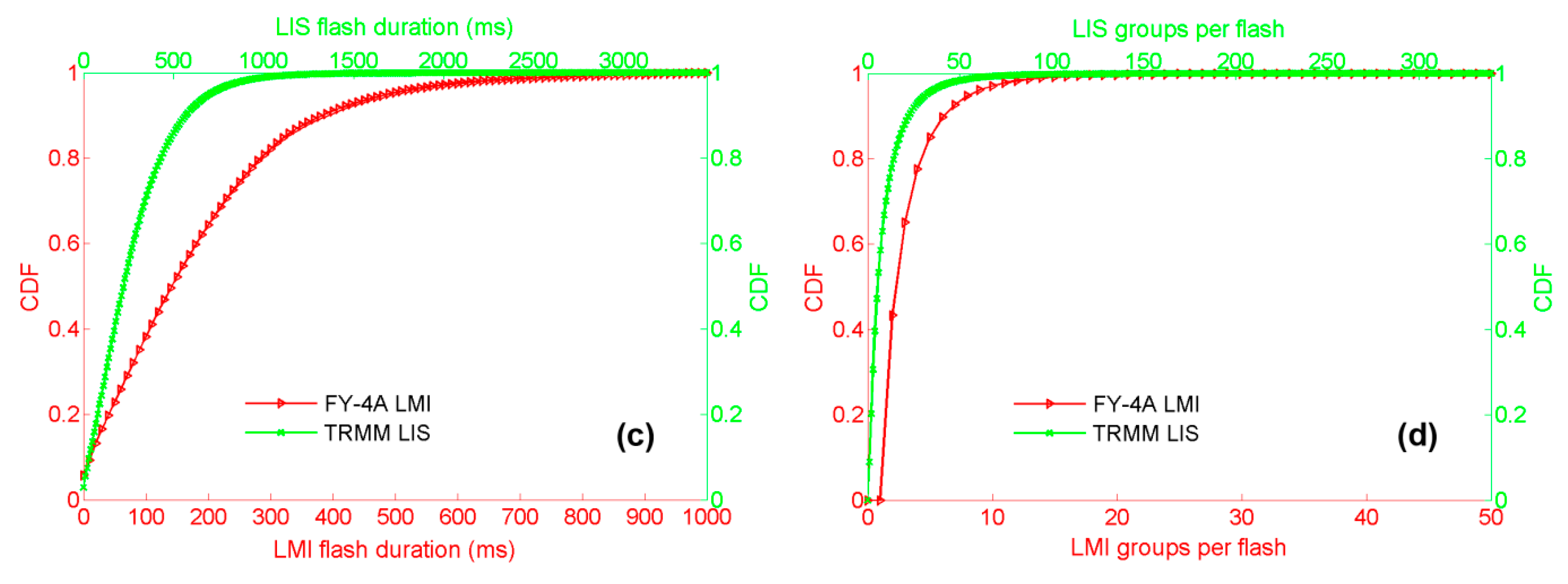
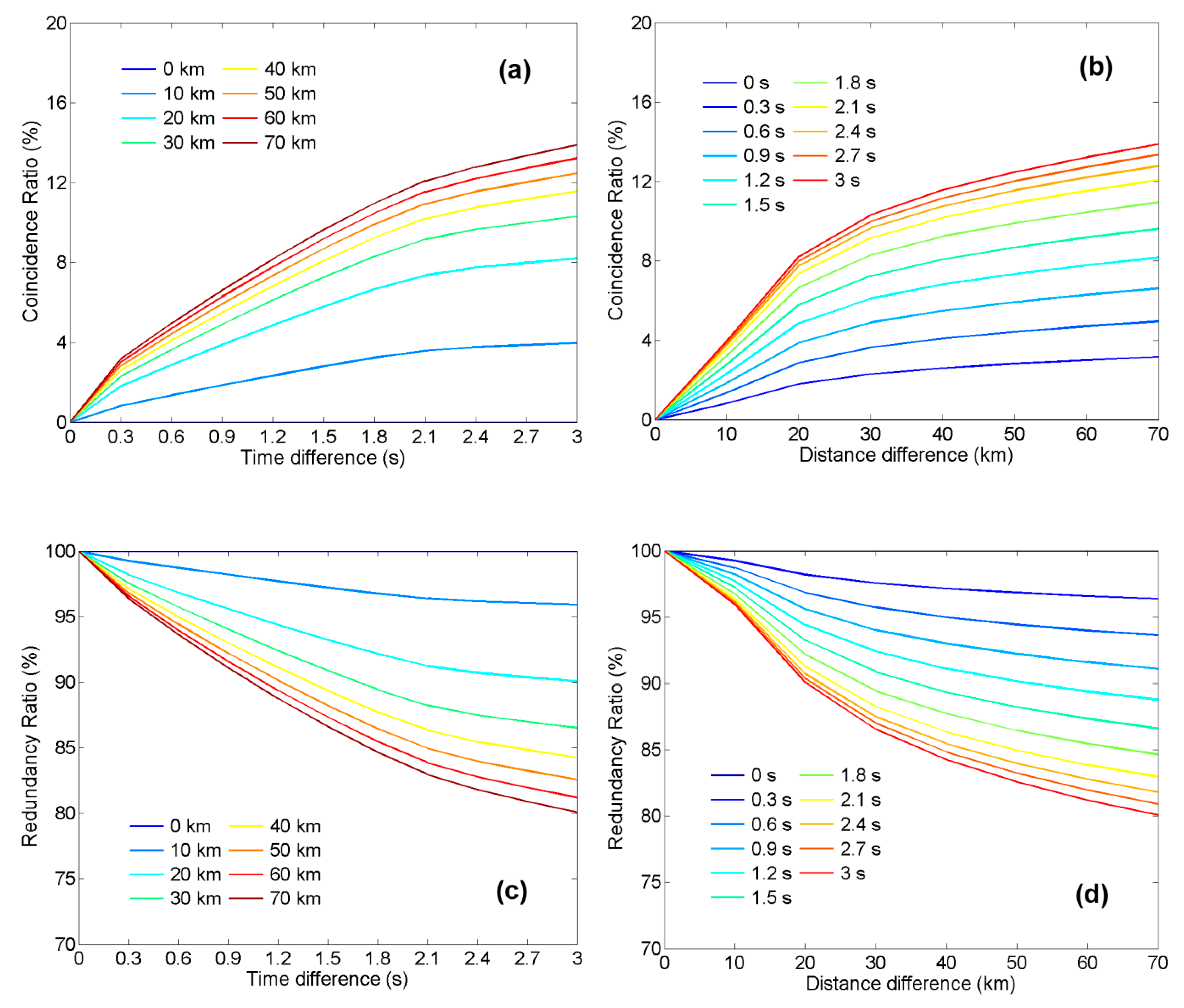
| Footprint Size (km2) | Duration (ms) | Groups per Flash | |
|---|---|---|---|
| Radiance (μJ sr−1 m−2 nm−1) | 0.73 | 0.44 | 0.23 |
| Footprint size (km2) | - | 0.44 | 0.33 |
| Duration (ms) | - | - | 0.53 |
© 2020 by the authors. Licensee MDPI, Basel, Switzerland. This article is an open access article distributed under the terms and conditions of the Creative Commons Attribution (CC BY) license (http://creativecommons.org/licenses/by/4.0/).
Share and Cite
Hui, W.; Zhang, W.; Lyu, W.; Li, P. Preliminary Observations from the China Fengyun-4A Lightning Mapping Imager and Its Optical Radiation Characteristics. Remote Sens. 2020, 12, 2622. https://doi.org/10.3390/rs12162622
Hui W, Zhang W, Lyu W, Li P. Preliminary Observations from the China Fengyun-4A Lightning Mapping Imager and Its Optical Radiation Characteristics. Remote Sensing. 2020; 12(16):2622. https://doi.org/10.3390/rs12162622
Chicago/Turabian StyleHui, Wen, Wenjuan Zhang, Weitao Lyu, and Pengfei Li. 2020. "Preliminary Observations from the China Fengyun-4A Lightning Mapping Imager and Its Optical Radiation Characteristics" Remote Sensing 12, no. 16: 2622. https://doi.org/10.3390/rs12162622
APA StyleHui, W., Zhang, W., Lyu, W., & Li, P. (2020). Preliminary Observations from the China Fengyun-4A Lightning Mapping Imager and Its Optical Radiation Characteristics. Remote Sensing, 12(16), 2622. https://doi.org/10.3390/rs12162622






